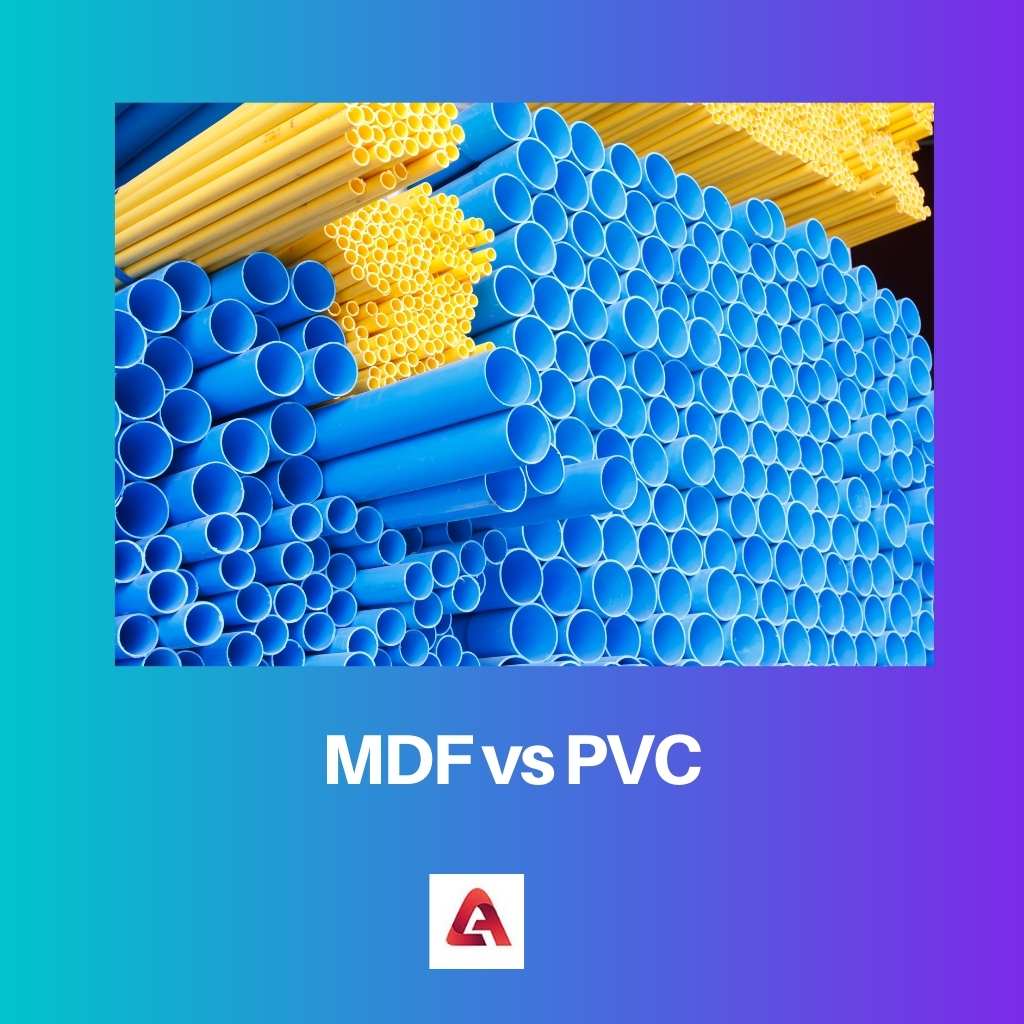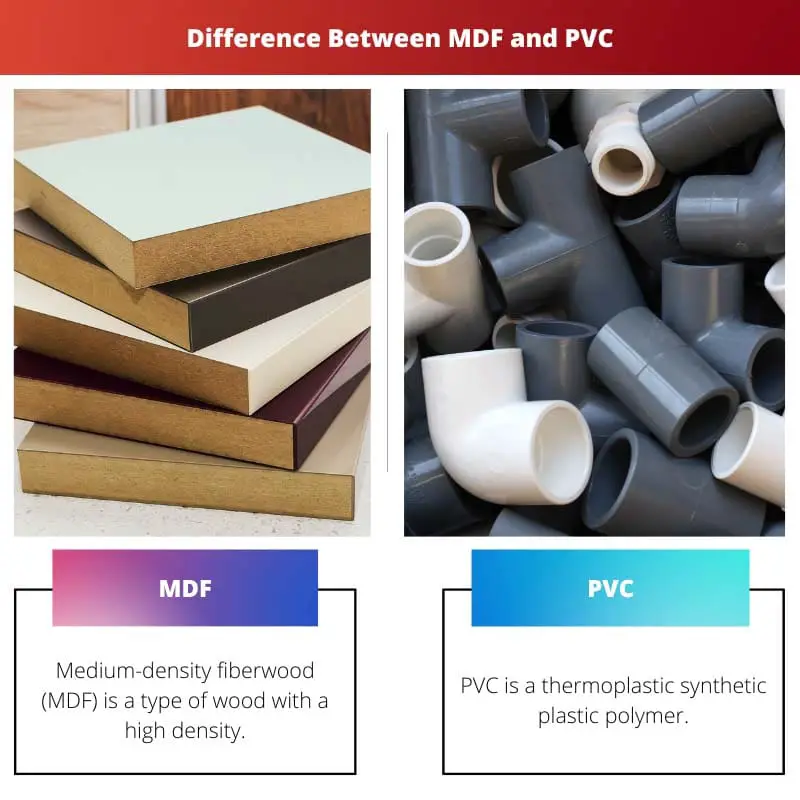In recent years, a variety of wooden boards for kitchen cabinets have been available. Plywood, Plyboards, and Medium Density Fiberboard are a few examples.
In today’s homes, MDF and PVC are popular choices for shelving and flooring. Both are fantastic additions to any house or company, enabling you to create a style that is unique to you.
Key Takeaways
- MDF (Medium Density Fiberboard) is an engineered wood product, while PVC (Polyvinyl Chloride) is a synthetic plastic polymer.
- MDF is heavier and more susceptible to moisture damage than PVC, which is lightweight, water-resistant, and durable.
- MDF is commonly used in furniture and cabinetry, while PVC finds applications in plumbing, construction, and electrical insulation.
MDF vs PVC
MDF is an engineered wood product that is made by combining wood fibres with a resin binder adhesive under high pressure to form it into panels. PVC is a type of plastic that is known for its durability, lightweight, and resistance to moisture. PVC comes in two basic forms, rigid and flexible.

Medium-density fiberwood (MDF) is a type of wood with a high density. In Europe and North America, a large-scale MDF began in 1980.
Eighty-two percent of MDF is made up of wood fiber, nine percent formaldehyde, eight percent water, and one percent paraffin wax. Medium-density fiberwood has a density of 500 to 1000 kilograms per cubic meter.
PVC is a thermoplastic synthetic plastic polymer. PVC is produced more than 40 million tonnes per year.
Pipes, as well as the construction of doors and windows, contain them. Food-safety sheets are one of the most common uses for this PVC.
Their ductility and malleability have made them a popular choice for a variety of items.
Comparison Table
| Parameters of Comparison | MDF | PVC |
|---|---|---|
| Full-Form | Medium-Density Fiberboard | Polyvinyl Chloride |
| Discovered | 1872 | The 1960s |
| Molding | Easier to mold | Harder to mold |
| Common Cuts | 49 by 97-inch panels;1.2- or 3.4-inch | 4 by 8-foot panels; 1.2 to 1-inch |
| Common Uses | Higher-end furniture and cabinetry etc., | Lower-end furniture and floor underlayment etc., |
What is MDF?
Medium-density fiberboard is a type of engineered wood. It is made out of wood fibers formed by the breakdown of softwood or hardwood residuals.
MDF can be used for a variety of purposes. It is mostly used in school projects due to its flexibility, and in furniture such as cabinets because of its strong surface.
Cutting significant amounts of MDF frequently results in the release of dust particles. As a result, respirators must be used when cutting.
MDF was first mass-produced on a large scale in the 1980s. North America and Europe were the first places where MDF was manufactured.
Color can be used to classify different varieties of MDF. Ultralight MDF, a moisture-resistant plate that is green, and fire retardant MDF, which is red or blue, are two examples.
It has several advantages. For starters, MDF is uniform in size and strength. Second, it may be molded into many forms. In addition, because MDF has less expansion and contraction than natural wood,
the dimensions it provides are rather stable. Another advantage of MDF is that it works well with wood glue and paint. MDF is also quite adaptable.
Unlike genuine wood, MDF has the same external surface as the core. If you sand the it, the fiber-waxed core will be exposed, compromising the board’s integrity.
In this instance, you’ll need to be extremely cautious when sanding, as this could weaken the board’s overall strength.
Although MDF has several disadvantages as well. It is denser than plywood and chipboard.
If the MDF is of poor quality, it is likely to swell or crack when saturated with water. Another downside is that if MDF is kept in humid surroundings without any wrappings or seals, it may distort or expand.

What is PVC?
PVC is a form of plastic that is widely used around the world and is the third most widely used material. PVC stands for polyvinyl chloride, which is a group of synthetic plastic polymers.
Eugen Baumann, a German chemist, discovered it in 1872. PVC is in high demand all over the world since it has a wide range of applications and is used to manufacture a wide range of products in our daily lives.
PVC is available in two different forms: rigid and flexible. The type of plastic used is determined by the application.
PVC in its rigid form is commonly utilized in construction and pipes. Bottles, computer cables, and other items made of flexible PVC are popular.
PVC comes in a wide range of shapes and colors. PVC comes in two different types: stiff and flexible.
The rigid form of PVC has numerous applications, such as pipeline construction and electrical insulation, but the flexible form has fewer applications and is widely employed in the production of plastic bottles.
As a result, while PVC is quite valuable in making our lives easier, it must be disposed of safely and carefully.
As the metal pipe is prone to corrosion, oxidation, and degradation, PVC is frequently utilized as a replacement. Because of its low cost, durability, and ease of installation, it is one of the most extensively used polymers in the world.
PVC is available in a variety of shapes and sizes, including plain and bell shapes.
When built properly, PVC has a 50-year lifespan. It does, however, have several drawbacks, such as difficulties meeting because of its high melting point.
Its solvent cracking resistance is insufficient.

Main Differences Between MDF and PVC
- MDF is an acronym for medium density fiberboard, whereas PVC is an abbreviation for polyvinyl chloride.
- MDF was discovered in 1872, whereas PVC was discovered in the 1960s.
- MDF is simpler to mold since it is resistant to chipping and ripping, but PVC is more difficult to form.
- 49 by 97-inch panels with 1.2- or 3.4-inch thicknesses are the most typical MDF cuts, whereas 4 by 8-foot panels with 1.2-to-1-inch thicknesses are the most popular PVC cuts.
- MDF is commonly used for higher-end furniture, cabinets, and shelving, whereas PVC is commonly used for lower-end home furnishings, floor underlayment, and as a replacement for bathrooms and kitchens worktops.

- https://www.sciencedirect.com/science/article/pii/S0261306909001332?casa_token=7jLXi2pmpoUAAAAA:xyjfY7gWihvMVgtXKlcFywY0z0A6Nkb0YnuiTtNEQuoC16Tx-q6mtelnc1h7u-iyjYCGgaPBbKfJ
- https://www.tandfonline.com/doi/abs/10.1080/17480272.2021.1881999
